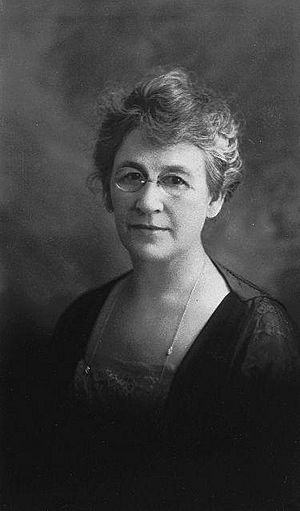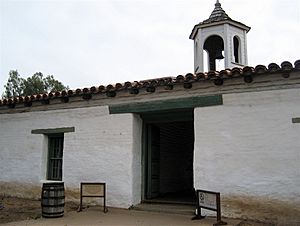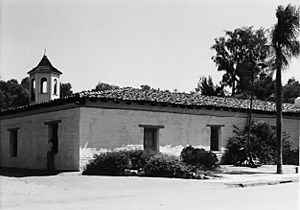Hazel Wood Waterman facts for kids
Hazel Wood Waterman (1865–1948) was an American architect from the early 1900s. She worked in southern California, creating buildings inspired by the Arts and Crafts movement. She is famous for being the first person to do a major update of Casa de Estudillo. This house is one of the oldest examples of Spanish architecture still standing in California.
Contents
Early Life and Learning About Architecture
Hazel Wood was born on May 5, 1865, in Tuskegee, Alabama. In the early 1880s, her family moved to Oroville, California. In 1882–1883, Hazel studied art at the University of California, Berkeley. There, she met Waldo Sprague Waterman, who would become her husband. His father, Robert Waterman, was a former governor of California.
Hazel and Waldo got married in 1889. They moved to Cuyamaca, where Waldo worked as a mine supervisor. In 1891, they moved to San Diego, where Waldo found a job with a railroad company. They had three children: Robert Wood, Helen Gardner, and Waldo Dean. The couple joined a local club and met many important people. These included architects Irving Gill and William S. Hebbard, landscape designer Kate Sessions, and businessman Julius Wangenheim. These connections would later help Hazel in her career.
In 1900, Hazel and Waldo hired Irving Gill to build their house. It was called "Granite Cottage." Hazel helped design the rooms, even choosing details like window frames. Gill was very impressed with her ideas. He thought she had a "natural talent" for architecture. Hazel enjoyed the experience so much that she wrote an article about it. It was published in House Beautiful magazine in 1902. She loved the American Craftsman style. This style used natural materials and simple shapes. It aimed to make buildings fit in with the nature around them. Like other women architects of her time, she also focused on features that made housework easier.
Hazel's life changed a lot in 1903 when Waldo died. She needed to find a way to support her family. Hazel started learning architectural drafting through a course she took by mail. Irving Gill also helped her. He gave her lessons in drawing at his office after hours. In 1904, Gill's company, Hebbard and Gill, hired her. She made architectural drawings from home. She also went to talks about the Arts and Crafts movement. Her own building style later combined Gill's modern ideas, inspired by the Prairie School, with the American Craftsman style.
Hazel's Architecture Career
After learning from Irving Gill, Hazel Waterman wanted to become an architect on her own. Gill helped her start her own business. Her first project came in 1905 from two of Gill's old clients. They were Alice Lee and Katherine Teats. Alice Lee wanted Hazel to design three houses near Balboa Park. She asked Gill to be the official architect for the project. This allowed Hazel, who was new to the field, to do the actual design work. Gill agreed and helped by watching over her work. Hazel designed the houses in a U-shape, sharing a common garden. Kate Sessions designed this garden. The Lee-Teats house was built in the Prairie style, similar to Gill's other projects. In 1910, her work on the Estudillo House showed Mexican influences. This was because she was inspired by Californian missions.
In 1906, Waterman opened her own office. She stayed close friends with Gill throughout her career. For about five years, she mostly designed homes in the Arts and Crafts style. Many of her designs connected the inside of the house with the outdoors. In 1911, she got her first project that wasn't a home. It was a new building for the Wednesday Club of San Diego. She was a long-time member of this club. For this building, she added new features to her style, like stucco. These elements honored the Spanish architecture of the region.
Waterman's most famous project came in 1910. Businessman John D. Spreckels hired her to restore Estudillo House in Old Town, San Diego. Estudillo House was one of the oldest examples of Spanish architecture in California. It had become famous earlier because of Helen Hunt Jackson's popular book Ramona (1884). Hazel used old records to figure out what materials to use. She also planned how the rooms and gardens should look. She also wanted to make the house easy to market as a Ramona-themed tourist spot. Her important work on this restoration was recognized. The Estudillo House was documented by the Historic American Buildings Survey in 1937.
Waterman also designed a building for the Children's Home in Balboa Park. She created a garden for Julius Wangenheim. In 1933, this garden won an award from the American Institute of Architects. Over the years, she hired several people to help her with drawings. These included Lilian Rice and her own daughter, Helen. She worked with local artists and designers, like tile maker Ernest A. Batchelder. Hazel was interested in many types of design. She often gave talks on different topics at the Wednesday Club.
Waterman took a break from architecture between 1915 and 1920. She seems to have stopped working as an architect completely in 1929. She retired in Berkeley, California, where she passed away on July 22, 1948. Her old papers and designs are kept at the San Diego History Center.
Buildings and Projects
| Name | Year | Other Information | Image |
|---|---|---|---|
| Cottage for Mrs. George Baoney | 1907 | ||
| Alterations for Dr. & Mrs. H.G. Leisediring | (no date) | ||
| Clayton Residence | 1912 | ||
| Miss Freeze Residence | 1908 | ||
| Captain A.A. Ackerman Residence | 1912 | ||
| Wednesday Club | 1909 | ||
| Mrs. Church Cottage | 1915 | ||
| Judge Walter J. Weed Residence | 1928-29 | ||
| Julius Wangenheim Garden | 1917 | ||
| Estudillo House Restoration | 1909 |
See also
 In Spanish: Hazel Waterman para niños
In Spanish: Hazel Waterman para niños




